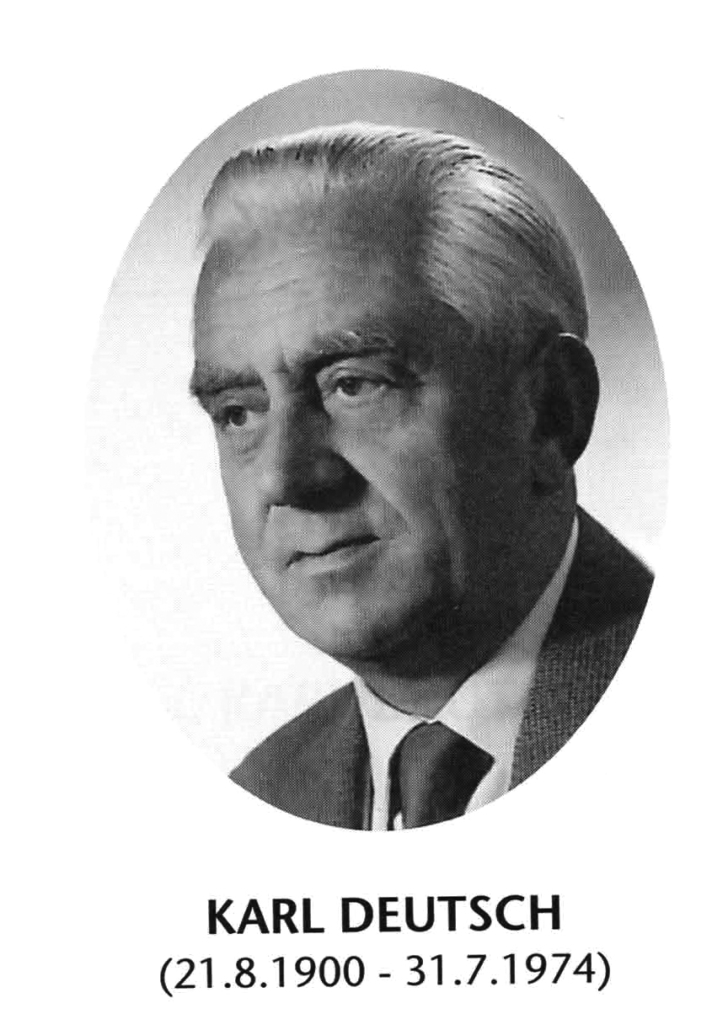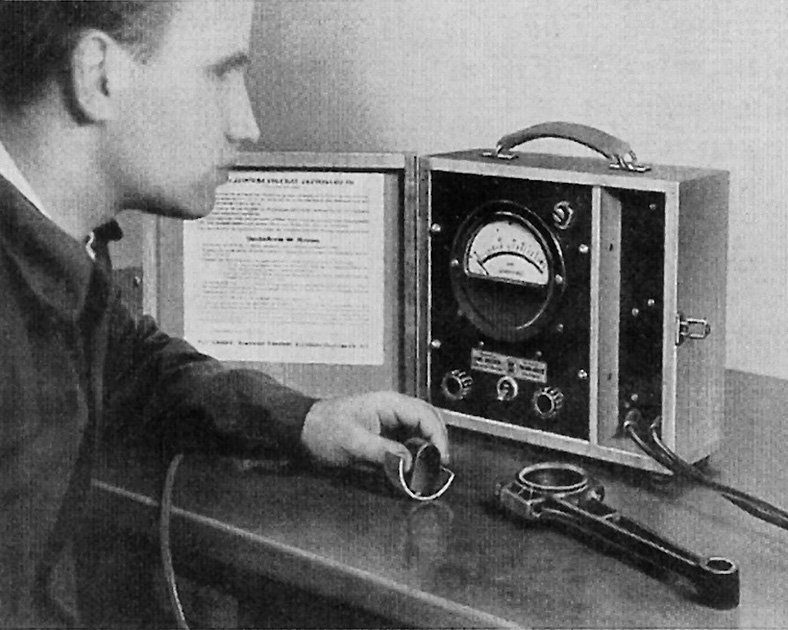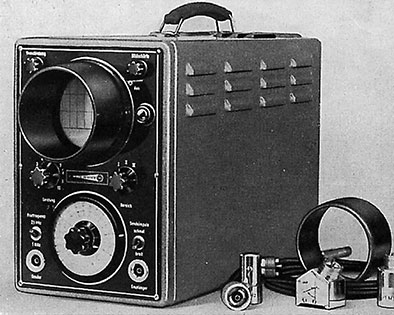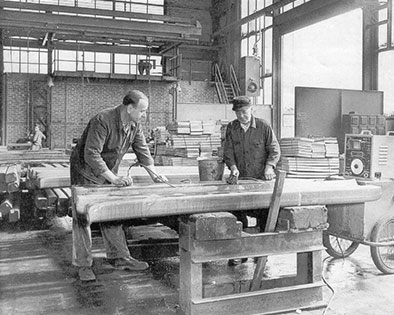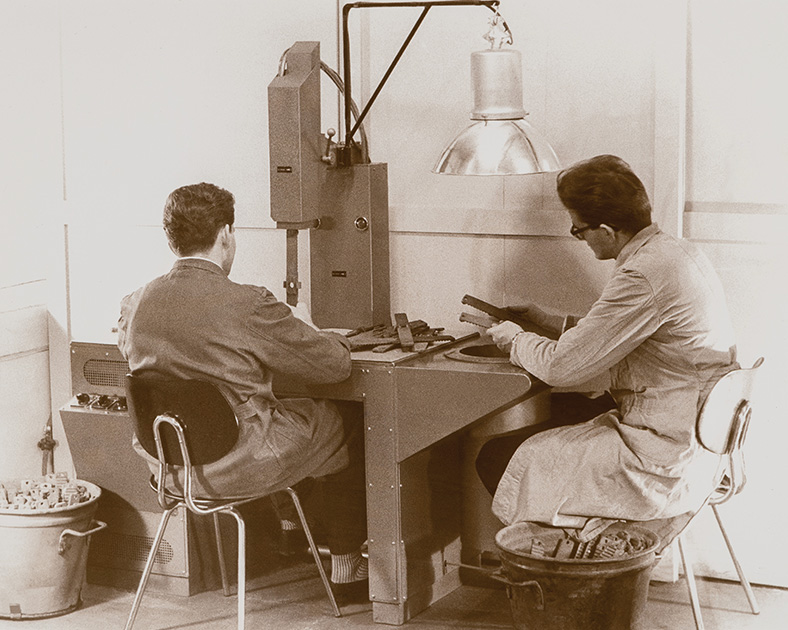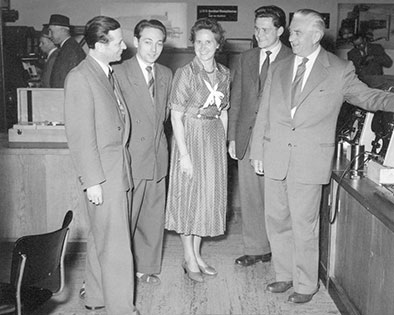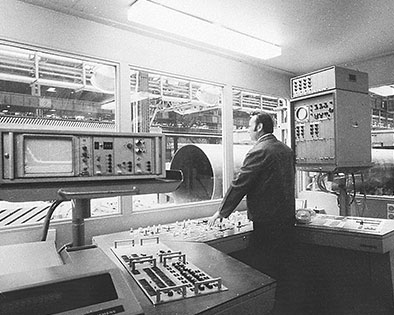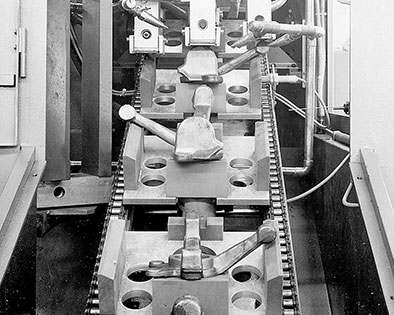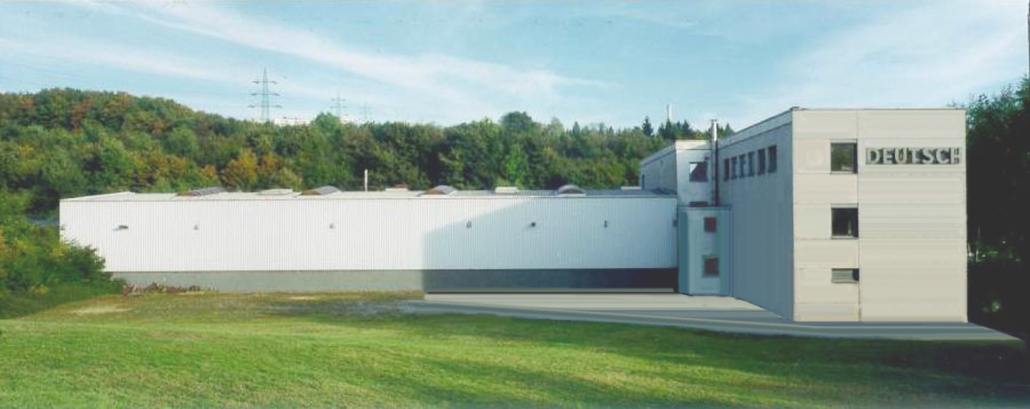History
The Beginning
After the terrible world war and chaotic post-war-years, Germany gradually returned to normality. There was new money – too little – but at least one could now buy something. The prices remained stable and hard work was once again rewarded. Some people were lucky to keep their property, home and friends. Many others lost everything except their will to work and their creative power which they now used with optimism.
Among those was Ing. Karl Deutsch. He was born in 1900 in Wittenberge/Prignitz (near Magdeburg, Germany). After the war, he was almost 50 years old. He lost all his property in East Germany but he managed to protect his family from the bombings. The entire family survived the long trek from East to West Germany and outlasted the black-market period. In his search for work after the capitulation, he drifted westward and in 1946 he became manager of a wire mill in Neuenrade (30 miles west of Wuppertal). The wire was made from aluminium alloy and it was suitable for metal spraying. Karl Deutsch became interested in this technique because it enabled to repair worn machine parts. This seemed promising.
Karl Deutsch was an ingenious engineer, He then set about improving the state of the art, which was not particularly impressive in this field. The result was a new spray gun with a complete new wire transportation system – his first patent after the war. A prototype was produced and it worked.
Company Foundation and the First Years
Initial experiments with the spray gun led to the need for measuring the thickness of the applied layer.
A coating thickness gauge was required but not available. Karl Deutsch was hoping to get help from the Institute for Material Science at the Technical University of Hanover, Germany, where research was done on metal spraying. Prof. Alexander Matting, Head of the Institute, could not help, but his senior engineer proposed to develop such a device together. Very soon a prototype was built. A small workshop was quickly found to produce the first small series. The name LEPTOSKOP was created while having a beer in a pub where someone was bragging about his high school education: “Leptos” is Greek for “thin”. Karl Deutsch believed that this instrument could be a stable base for his own new business.
At the Hanover-Fair in 1948, Karl Deutsch had a booth which was “very small, far back in a corner and close to the toilets, therefore cheap but everybody had to pass by”, as he recalled later. There, he had a lucky encounter: He met senior employees of the trading company Hahn & Kolb from Stuttgart which is an important partner until today. They knew each other from working together during the war. More or less out of pity, Hahn & Kolb offered to act as a distributor for Karl Deutsch’s LEPTOSKOP. They met again in Wuppertal, the new home town of the family. An order for 25 devices was placed. Karl Deutsch was also offered the Hahn & Kolb agency for the area in and around Wuppertal. He founded his new company on May 13th, 1949, and specifies the aims of his company with the subheading “Spraying & Welding Equipment”.
Representing Hahn & Kolb was a lot of work, but also valuable especially since many industry contacts resulted from this position. One day, the head of the research laboratory of a small steel mill showed Karl Deutsch a journal paper on the Sperry Refectoscope: the world’s first ultrasonic flaw detector. It was developed during the war to find delaminations in the armored plating of tanks. He thought that this device would be useful for the German steel industry and “the market should be big enough to sell 10 units per year”.
LEPTOSKOP – The first coating thickness gauge
Moritzstraße Wuppertal: First company site and private home of the family
Karl Deutsch showed this paper to a young man named Werner Branscheid who had approached him and has offered to build “something electronic”. He used to be a radio operator during the war and he “kept” a large stock of electronic valves from the army. Ihm zeigte Karl Deutsch den Zeitungsartikel. Branscheid was excited and offered to build a similar device within 6 months for 5,000 German marks. It took him longer and it also cost more money than expected but progress was made. The first experiments seemed promising but suddenly the whole project was in danger: A presentation on ultrasonic testing was given in Düsseldorf by a man who was unknown at that time, Dr. Josef Krautkrämer. He had also developed a flaw detector and, what was worse, he was already finished.
Ing. Karl Deutsch at the Hanover trade show
ECHOGRAPH Ultrasonic Testing
Nevertheless, Karl Deutsch and Werner Branscheid kept working and introduced their instrument under the name ECHOGRAPH. The first order is well remembered: During a presentation of the instrument at a hammer forge near Wuppertal, a large crankshaft was under inspection. An interior flaw was detected. The production manager did not believe the test result but agreed to cut open the shaft under the condition “If there is no flaw you will pay for the damage!” A crane was used to move the shaft but it slipped from the crane and fell on the ground. It broke exactly at the marked position and a large interior flaw was visible. The owner of the company immediately ordered the instrument with the words “Don’t dare to offer the ECHOGRAPH to my customers!”
The company became more successful and very soon Branscheid’s laboratory, an old garden shed, was too small. Karl Deutsch decided to organize the production by himself and let Branscheid do the R&D. He rented a few rooms in a former butcher’s store close to his appartment and hired three employees besides his secretary.
Development was abruptly interrupted in 1955. A patent litigation developed concerning the ECHOGRAPH. To further complicate matters, Branscheid was left disabled after a severe car accident. Karl Deutsch could not afford a lawsuit against an American giant, so he turned his attention to negotiation and looked for new areas of development.
He had many ideas: Equipment to measure cogwheels, continuous on-line measurement of the thickness of steel an control of the force of hydraulic presses (similar to modern electronic testing machines). However, the development program was inversely proportional to the technical and financial recources. The LEPTOSKOP and the Hahn & Kolb agency were sufficient to live on.
ECHOGRAPH UMG 10: First ultrasonic flaw detector
Ultrasonic billet testing in Witten steel mill (today DEW)
HOESCH Dortmund: Helical pipe testing
DEUTROFLUX Magnetic Particle Crack Detection
Once again, luck played an important role: In a forge in Düsseldorf, a clever inspector built a new device for magnetic particle testing. Dry magnetic powder in a chamber was held in a liquid-like state by introducing homogeneously distributed compressed air. Magnetized test pieces were immersed in this powder bath and surface cracks were easily detected as fluorescent lines under UV illumination. Karl Deutsch immediately realized the importance of this “vortex chamber”. He carried out his own tests and optimized the air supply where his prior experience in compressor construction was very helpful. A device was built and its demonstration caused great enthusiasm among the customers.
The technique seemed optimal for the inspection of forged pieces and in addition, there was a large demand for such an inspection technique as the German car industry was booming. Karl Deutsch found a suitable building and started promoting his DEUTROFLUX devices (DEUtsch-TROcken-FLUX, where “trocken” means dry). Another instrument also started selling well: the RMG crack depth meter.
The old butchery became too small. A former textile factory in Wuppertal-Barmen provided more space. The rooms were far too big for his team of twelve, but Karl Deutsch believed in expansion as his son Volker Deutsch would soon be joining the company.
DEUTROFLUX: Vortex chamber for testing with dry powder
Generation Shift 1961
Starting in 1953, Volker Deutsch attended the Technical University in Aachen, Germany. After receiving his Diploma in Mechanical Engineering he moved to Hanover where he received the Doctoral Degree from the Institute for Material Science under Prof. Alexander Matting in 1961. During those years, Volker Deutsch made some extra money by working for the Federal Authority of Material Testing. Those four years of practical experience proved to be extremely valuable. He was also involved in organizing the first courses on non-destructive testing offered by the DGZfP (German Society for NDT) outside of Berlin.
Before Volker Deutsch joined the company, Karl Deutsch had discontinued the cooperation with Hahn & Kolb because he wanted to concentrate entirely on devel-oping and marketing his own products. The product range was streamlined: The surface roughness gauge (MICROGEOMETER) including its patents were sold. The electro-polishing apparatus (POLIMAT) and the press-force controlling equipment were put on ice and all activities outside NDT were discontinued. This included equipment for measuring lengths and distances using magnetic induction probes as well as medical ultrasound. Volker Deutsch’s suggestion to give up ultrasonics and to concentrate on the promising area of magnetic particle testing was overruled by Karl Deutsch. He believed in the old German saying “Two legs are better to stand on!” So it was decided to employ competent electrical engineers to apply the new transistor technology and to develop the next generation of instruments.
The company also had to work on expanding the markets and to overcome regional barriers. Consequently, Volker Deutsch often traveled within and outside of Germany. He demonstrated equipment and searched and found many business partners and friends. The many discussions were fruitful and resulted in improved products. Success was not long in coming. The turnover increased by 10 % to 25 % each year – figures you will not easily find today. The number of employees grew and already in 1967, Works 1, the first own company building was planned and financed.
Volker Deutsch / Werner Branscheid: Inspection of wheelsets
Paul Höhle, Heinz-Johann Schinke, Irma Deutsch, Dr. Volker Deutsch, Ing. Karl Deutsch: Hanover trade show
Growth of the Company
When Karl Deutsch handed the company over to his son, his business consultant warned him that “the son could fire him”. Karl Deutsch did not think that this was a big risk. The company continued to expand. It was reorganized and computer usage improved the organizational efficiency. Many competent employees were hired and most of them stayed. In 1977, more than 30 of the 100 employees had been with the company for more than 10 years. Expansion continued at a moderate pace and was generally achieved with the company’s own financial means. Karl Deutsch did not like to buy on credit.
Due to further expansion, Works 1 became too small and in 1972 a four-story annex was erected. In 1978, the growth of the testing system division required the second building, Works 2.
In 1974, Karl Deutsch died unexpectedly. However, he had the chance to see the fruits of his work, namely the extension of Works 1 and the establishment of the first foreign subsidiary company in Sweden.
The decline of the nuclear power plant industry in Germany after the Chernobyl disaster, the weak US-Dollar, the change of the industrial landscape in Germany and the loss of Eastern European markets after the reunification also affected the situation of KARL DEUTSCH. Nevertheless, most companies in the field would be grateful to have coped with those circumstances as well as we did.
One highlight was the 50th company anniversary in 1999. A big celebration was organised for the employees and the occasion was used to thank all the good customers who are crucial for a company’s success. More than 150 customers and friends followed the invitation to Wuppertal. Of course, drinks and food were provided but the focus was placed on presentations especially on ultrasonic testing systems – a successful product line at KARL DEUTSCH for many years.
Another legendary party was held during the annual conference of the German NDT society DGZfP in Celle, Germany. The event was jointly hosted together with the Krautkrämer company. The motto was “50 Years Ultrasonic Testing in Germany”.
ECHOGRAPH-SNUL: LSAW pipe testing at Mannesmann in Mülheim
DEUTROMAT: Magnetic particle inspection of steering knuckles
New workshop for the production of testing systems (Works 2)
Generation Shift 2001 and KARL DEUTSCH Today
Dr. Wolfram A. Karl Deutsch studied electrical engineering at the University of Hanover, Germany. His diploma thesis and doctorate in Chicago dealt with ultrasonic testing. In May 1998, he joined KARL DEUTSCH and started to work for the division of ultrasonic testing systems. The long-term division manager Dr. Peter Möller died during vacation due to a crash with a light aircraft. Michael Joswig was appointed as new division manager. Rainer Kattwinkel supported him as deputy. This team proved to be highly successful during the next years.
After 40 years in charge, Prof. Volker Deutsch retired at the end of the year 2000. Nobody believed that he would stop working – but he kept his promise that there should not be two decision makers at the same time. Dr. Wolfram Deutsch, now 33 years old, could rely on the experienced executive team with Dr. Michael Platte and Hans-Willi Krümmel. The product division managers Dr. Michael Lach, Frank Bartholomai, Michael Joswig and Dr. Ralf Wagner also provided a high level of continuity.
The testing system divisions showed a solid turnover and this resulted in three extensions of Works 2 (2004, 2006, 2013). The assembly area was more than doubled. Until today, all testing systems are mechanically designed in-house by a team of 8 engineers and fully assembled in Works 2. Large testing systems, which previously were assembled in tents in the garden of Works 2, could now be assembled in without space restrictions.
China was the most important export market. Olaf Deutsch, the brother of Wolfram Deutsch, has lived in Beijing since 1999. He joined as General Manager of the Beijing office in 2005. He is supported by Zhang Zhengxin, who started working for KARL DEUTSCH in 1989. This cooperation was very effective. In 2015, the 25th anniversary of KD-China was celebrated. By then, 150 testing systems had been sold.
In 2007, a joint development with the BAM institute in Berlin was started. A Phased Array module for ultrasonic testing systems was introduced. In 2009, KARL DEUTSCH took the chance and purchased the first shares of the French M2M company. Later, additional shares were bought and 33 % were reached. Until today, M2M (today a 100 % subsidary of EDDYFI, Canada) is the R&D-Partner for Phased Array products. In 2010, the first Phased Array tube testing system was shipped to Vallourec in France. In 2014, the portable GEKKO PAUT flaw detector with TFM flaw imaging was introduced.
In 2019, Dipl.-Ing. Dietger Schäle was appointed as Managing Director. He had been working for the company since 2004 as an R&D engineer. In 2011, he became successor of Dr. Michael Platte as Technical Director. Thus, management responsibilities can now be distributed in a better way and a continuous transition to the fourth family generation can be ensured.
Dr. Wolfram Deutsch: Joining the company
Second workshop extension in Works 2
ECHOGRAPH RPTR-PAUT: First Phased Array testing system
Dr. Wolfram Deutsch / Dipl.-Ing. Dietger Schäle: Extended management

